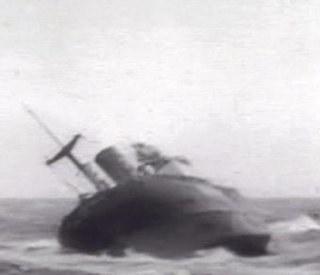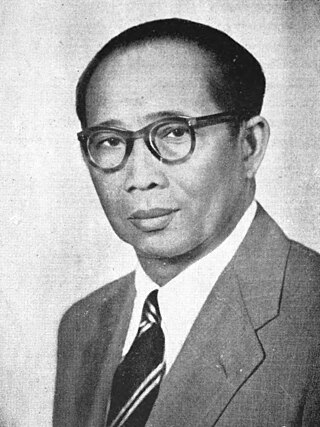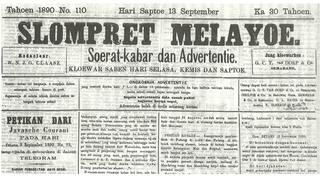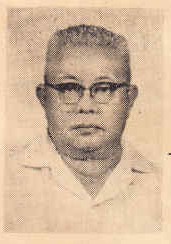Related Research Articles

The Bermuda Triangle, also known as the Devil's Triangle, is an urban legend focused on a loosely defined region in the western part of the North Atlantic Ocean where a number of aircraft and ships are said to have disappeared under mysterious circumstances. The idea of the area as uniquely prone to disappearances arose in the mid-20th century, but most reputable sources dismiss the idea that there is any mystery.

Mary Celeste was a Canadian built, American-registered merchant brigantine that was discovered adrift and deserted in the Atlantic Ocean off the Azorean islands on December 4, 1872. The Canadian brigantine Dei Gratia found her in a dishevelled but seaworthy condition under partial sail and with her lifeboat missing. The last entry in her log was dated ten days earlier. She had left New York City for Genoa on November 7 and was still amply provisioned when found. Her cargo of alcohol was intact, and the captain's and crew's personal belongings were undisturbed. None of those who had been on board were ever seen or heard from again.

A ghost ship, also known as a phantom ship, is a vessel with no living crew aboard; it may be a fictional ghostly vessel, such as the Flying Dutchman, or a physical derelict found adrift with its crew missing or dead, like the Mary Celeste. The term is sometimes used for ships that have been decommissioned but not yet scrapped, as well as drifting boats that have been found after breaking loose of their ropes and being carried away by the wind or the waves.

The Adventures of Superman is a long-running radio serial that originally aired from 1940 to 1951 featuring the DC Comics character Superman.

Citations here after reading.

SS Flying Enterprise was a 6,711 ton Type C1-B ship which sank off Cornwall in 1952. She was built in 1944 as SS Cape Kumukaki for the United States Maritime Commission for use in World War II. The ship was sold in 1947 and operated in scheduled service under the name Flying Enterprise. At the end of 1951, on a voyage from Hamburg to the USA with mixed cargo and a few passengers, she was crippled by storm damage and shifting cargo. Passengers and crew were evacuated. Three weeks of effort to save the ship having failed, she sank in January and some of the cargo was later salvaged.

SS Marine Sulphur Queen, formally Esso New Haven, was T2 tanker converted to carry molten sulphur. It is notable for its disappearance in 1963 near the southern coast of Florida, taking the lives of 39 crewmen.
The Octavius was a legendary 18th century ghost ship. According to the story, the three-masted schooner was found west of Greenland by the whaler Herald on 11 October 1775. Boarded as a derelict, the five-man boarding party found the entire crew of 28 below deck: dead, frozen, and almost perfectly preserved.

Marlborough was an iron-built two-decked merchant sailing ship which disappeared in 1890. She was built by the firm of Robert Duncan and Co., Port Glasgow and launched in 1876. First managed by James Galbraith for the Albion Shipping Company, she was registered in 1880 to the ownership of John Leslie of London, while continuing to operate within the fleet of Albion Line. Marlborough disappeared during a voyage in January 1890, and has not been seen or heard from in over a century. Searches and investigations have yielded nothing conclusive, and the ship's ultimate fate, and that of her crew, remains unknown.
SS Aquila was a cargo ship built in Britain in 1940 for Stavros Livanos' Trent Maritime Co Ltd. by William Gray & Company. An identical sister, Duke of Athens, was built for Trent at the same time.

Suharso, (1912–1971) also spelled Soeharso, was an Indonesian medical doctor known for his work with disabled people and in the rehabilitation of people injured during the Indonesian National Revolution. He was declared to be a National Hero of Indonesia in 1973.

Bintang Merah was a magazine of the Communist Party of Indonesia which published in Jakarta from 1945 to 1948 and again from 1950 to 1965. It described itself as a magazine of Marxist-Leninist politics and theory.

The Dark Pictures Anthology: Man of Medan is a 2019 interactive drama and survival horror video game with paranormal horror elements developed by Supermassive Games and published by Bandai Namco Entertainment. It is the first out of eight planned installments in The Dark Pictures Anthology, a series of standalone horror video games. Man of Medan features a cast of five playable protagonists and a multilinear narrative influenced by player choice. The game's decision-making scenes, of which there are several, can significantly alter the trajectory of the plot and change the relationships between the main characters. Due to these choices, any of the five protagonists can die permanently.

Sidik Djojosukarto was an Indonesian politician who served as chairman of the Indonesian National Party (PNI) from 1950 until his death. As PNI chairman, he was revered by all party factions, and was the closest to being an "authentic party hero."
Ko Kwat Tiong Sia (1896–1970), known as Mr. Ko Kwat Tiong and later Mohamad Saleh, was a prominent Indonesian politician, lawyer, civil servant and university lecturer. He was elected to the Volksraad in 1935 as a representative of the Partai Tionghoa Indonesia, and – after Independence in 1945 – headed the Balai Harta Peninggalan in Central Java until retiring in 1960.
Warna Warta was a Malay language Peranakan Chinese newspaper published in Semarang, Dutch East Indies from 1902 to 1933. Alongside its more popular rival Djawa Tengah, it was highly influential among the Chinese Indonesian population of Semarang during this time.

Selompret Melajoe was one of the first Malay language newspapers to publish in the Dutch East Indies. It was printed in Semarang, Central Java from 1860 to 1920.

The Dark Pictures Anthology is an anthology series of interactive drama and survival horror video games developed by Supermassive Games and published by Bandai Namco Entertainment. The anthology is planned to consist of eight games, with each game inspired by a different horror genre. Each game features five main characters whose survival depends on the choices made by the player. While each character only appears in one game, face models are often reused in other games, except those of the leading actors. The games use a third-person perspective and the ability to choose from various dialogue options and courses of action.

Thio Thiam Tjong was an Indonesian politician, community leader and businessman whose public career spanned from the late colonial period to the early decades of Independence. He was a founding board member in 1928 of Chung Hwa Hui, a Chinese-Indonesian, colonial political party, and was President of the group's post-WW II political successor Persatoean Tionghoa, formed in 1948, then renamed Partai Demokrasi Tionghoa Indonesia in 1950.

Oen Tjhing Tiauw was a Chinese Indonesian writer, politician and cultural figure active in the Dutch East Indies and Indonesia from the 1920s to the 1970s. From the 1930s onwards he was sympathetic to Indonesian nationalism and worked towards independence from the Dutch as a member of the Partai Tionghoa Indonesia and later the Socialist Party of Indonesia.
References
- ↑ "Crew Dies In S.O.S. Mystery". Daily Mirror . November 22, 1940. p. 11.
- 1 2 Estelle (December 29, 2015). "The Myth of the Ourang Medan Ghost Ship, 1940". The Skittish Library. Retrieved 2019-04-02.
- 1 2 3 4 5 6 7 Bainton, Roy (September 1999). "A Cargo of Death". Fortean Times. p. 28. Archived from the original on 2007-02-05.
- 1 2 3 "We Sail together". Proceedings of the Merchant Marine Council. U.S. Coast Guard. 9 (5): 107. May 1952.
- ↑ "Secrets of the Sea" (PDF). October 10, 1948. Retrieved November 22, 2016. and page 25
- ↑ "alphaDictionary: orangutan" . Retrieved 2007-04-20.
- ↑ "Een Mysterie van de Zee". De locomotief : Samarangsch handels- en advertentie-blad. February 3, 1948.
- ↑ "Ondergang der "Ourang Medan"". De locomotief : Samarangsch handels- en advertentie-blad. February 28, 1948. Archived from the original on December 21, 2013. Retrieved December 19, 2013.
- 1 2 "Mysterie der "Ourang Medan"". De locomotief : Samarangsch handels- en advertentie-blad. March 13, 1948.
- ↑ Readings in policy and practice for international business, Edwin F. Wigglesworth, T. Ashwell, 1959
- ↑ Estelle (December 29, 2015). "The Myth of the Ourang Medan Ghost Ship, 1940". The Skittish Library. Retrieved 2017-05-08.
- 1 2 3 4 Gaddis, Vincent (1965). Invisible Horizons. Ace Books, Inc., New York. pp. 125–126. ISBN 0-441-37177-9.
- 1 2 Edwards, Frank (June 1953). "Strangest of All". Fate Magazine.
- 1 2 Raybin Emert, Phyllis (1990). Mysteries of Ships and Planes . Tom Doherty Associates, Inc., New York. ISBN 0-8125-9427-4.
- 1 2 Winer, Richard (2000). Ghost Ships. Berkley. ISBN 0-425-17548-0.
- ↑ "MYSTERY S O S FROM DEATH SHIP" . Yorkshire Evening Post. No. 15634. 21 November 1940. p. 5. Retrieved 21 February 2021– via British Newspaper Archive.
- ↑ "CREW DIES IN SOS MYSTERY" . Daily Mirror. No. 11531. 22 November 1940. p. 11. Retrieved 21 February 2021– via British Newspaper Archive.